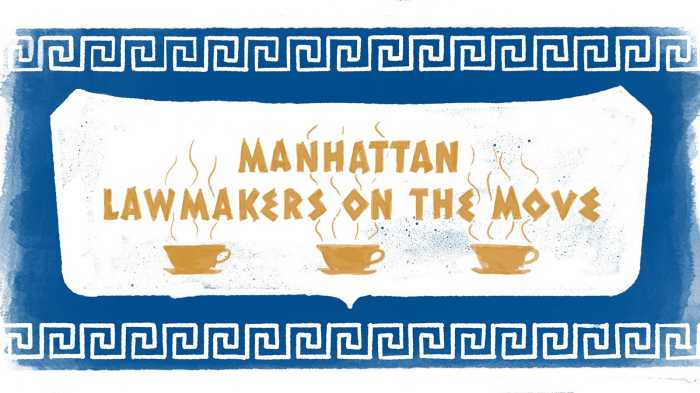In the past few months, we’ve seen a plethora of challengers rise up to challenge Representative Jerrold Nadler (D-Manhattan, Brooklyn) for his congressional seat. One such challenger is Lindsey Boylan, a former Special Advisor to Governor Andrew Cuomo (D) who specializes in urban planning.
Boylan has been one of Nadler’s most outspoken critics since she announced her candidacy. She claims that the longtime incumbent has shown a continuous reluctance to challenge the status quo, particularly in regards to housing reform and renovating our infrastructure to prepare for climate change. If elected, she promises to tackle both of those issues, among others, head-on. At the age of 35, she will be making her first ever bid for public office.
I got the opportunity to have a chat with Ms. Boylan over the phone yesterday afternoon. The following is a transcript of our interview.
NYCP: I read that your work in New Orleans after Hurricane Katrina inspired you to pursue a career in urban planning. Tell me more about that.
LB: It was the fall of my senior year of college. [The disaster] was, obviously, devastating for all of us to watch on the news, the scale of the destruction. And these conversations about rebuilding it in an equitable way were so important and so critical and I wanted to be a part of that.
So I did some work in New Orleans, gutting of homes and things, and it felt like the most important question was how to rebuild it in an equitable way. Of course, in hindsight, that has not really been the reality with New Orleans, but the question remains the same; how do you respond to a natural disaster or a crisis in a way that is helping those most in need?
NYCP: Are there any particular experiences in New Orleans that stuck with you? Any moments or faces you remember?
LB: Our role was gutting homes, because they were flooded heavily. And you had to strip homes down in order to rebuild them, and it was really grueling, hard work. I remember there was this one family whose house we were gutting, and they had lost everything. They brought over some homemade chicken soup for us while we were working. And I’ll never forget that; it was the best chicken soup I’d ever had.
NYCP: Prior to the fall of 2018, you were working as an advisor to Governor Andrew Cuomo (D). What did you do in that capacity?
LB: I was Deputy Secretary for Economic Development and a Special Advisor. I was the person who oversaw economic development and housing portfolios and within that, I did things like overseeing the state’s response to Hurricane Maria in Puerto Rico. It was sort of like a connecting point, returning to the scene that has been an important part of my life.
When I took on that housing portfolio, I oversaw the storm recovery department, which was doing all the work rebuilding after Hurricane Sandy. Nine years on, we were still overseeing critical work on Long Island – so I got to see that again, in addition to Hurricane Maria. It was an opportunity to engage in how we help people, and some of the most critically important, oftentimes traumatic experiences are a common thread here.
It’s part of what I find so important about dealing with climate change. Whether we’re talking about Sandy or Maria, these extreme weather patterns have only been increasing. The ability of the federal government to respond from a financial and operational standpoint is insufficient, obviously.
NYCP: On the subject of climate change, I think the consensus is that our approach has to be two-pronged. On one hand, we have to work to mitigate the effects of climate change by reducing emissions. On the other hand, climate change is already happening, so we have to rebuild our infrastructure to prepare for that.
LB: Absolutely. And I think for a district that has so much coastline, that emphasis on preparing the infrastructure for an already changed reality is key. EDC did a study that by 2050, there will be regular storm surge flooding in lower Manhattan. If we don’t prepare in terms of infrastructure, our coastal cities will suffer. And it’s not just about New York; it’s about the country.
NYCP: Was your work in Puerto Rico what inspired you to make a bid for public office?
LB: It was certainly a big part of it. I mean, it changed my life in so many ways. A common thread I’ve seen in most of the areas that I’m interested in – and this has been the case over the past ten or so years – cities are leaving in innovation, while states are leading in protection and advancing on various issues. And New York, as much as we provided assistance in Puerto Rico, we couldn’t do it alone.
The federal government, particularly the presidential administration, was not doing all that it could. And the cities and states can’t face the biggest issues of the day alone. We need Congress to act, we need Congress to push back against the administration, and we need advocacy. And that advocacy, I think, is best exemplified by most of our new leaders, predominantly women.
NYCP: In March of 2019, the DCCC announced that they would no longer be working with political candidates who challenge sitting Democrats. Why do you think the party is reluctant to support new candidates? Would you say it’s borne of a general reluctance to challenge the status quo?
LB: I think, unfortunately, that this policy was really a direct response to challengers that won in safe districts. They billed it as a policy that would protect the majority in the house. But AOC, Ro Khanna, Ayanna Pressley, these challengers all won in districts who were overwhelmingly democratic.
We’re not seeing challengers beat incumbents who might lose the seat to a Republican. I say that to negate the idea that this has anything to do with protecting the majority. It’s just protecting the status quo and the incumbency. And that is not a way to lead; that is not a way to innovate; that is not a way to produce the best policies or produce the best leaders. It’s not why I’m running, but it is absolutely a motivating factor.
Congressman Nadler has been the chief author for three pieces of legislation in thirty years, two of which are ceremonial. He co-sponsors a lot [of legislation], but overall, this is not a productive way to lead. Yet, there isn’t even any conversation around that, because we haven’t pushed our electeds to do more, to produce more, to influence change.
NYCP: Speaking of which, I’ve heard you talk a lot about the housing crisis in New York – like the dour state of NYCHA, or the lack of affordable housing. If elected, what would be your first step in addressing the housing crisis?
LB: Housing is one of the key indicators of inequality in this 2020 cycle, and there are a few things we need to do right away. There’s over $30 billion in terms of deferred investment needs in NYCHA, and that has to be front and center.
At the federal level, we need people to come back to the table. We need a member of Congress who’s engaged on a consistent basis in pushing NYCHA’s management in the city. As it stands now, we have a NYCHA head who’s commuting from Minneapolis. I don’t know how that possibly works.
We need to increase the number of Section 8 housing vouchers, because we have a years-long waitlist. Over 20,000 kids in New York City are sleeping in shelters, because even if they qualify for vouchers, there’s such a long wait to get access to them. So people are growing up in really unacceptable conditions.
And I think, frankly, we need a bigger idea for the 21st century of workforce housing investment at the federal level. We need innovative solutions for this. In each one of the community boards in our district, housing is the number one issue. And it’s not just a problem for any particular income bracket. 30-34 percent of people in every CB district are severely rent-burdened, meaning they can barely afford to stay here.
NYCP: Lastly, I’d like to talk about the district you’re challenging Nadler for. The 10th Congressional District is incredibly diverse, spanning multiple neighborhoods across Manhattan and Brooklyn. How do you intend to approach the challenge of ensuring that your policy benefits all of your constituents?
LB: I’ve been to Community Board 12 and 7 – complete opposite ends of the geographic spectrum in the district. If you look at their community planning, the top issue for both districts is housing.
Now, the immediate reality of what’s causing that for each district differs; there are different drivers for each. But there’s still a lot in common. And the housing issue, issues that make it much more challenging related to inequality are big.
Furthermore, this is a district with roughly 12 percent of its households on SNAP benefits. We’re a quote-unquote “wealthy” district compared to most other districts in the country, but across the district you have these extremes of people who we need to advocate for. And that’s not different between a Brooklyn part of the district and a Manhattan part; dealing with that inequality is a universal issue in District 10.
So is climate change. Whether you’re talking about Lower Manhattan or Red Hook, we all have the reality of having to focus on investments in climate change. That means thinking through how to stop the worse of global warming from progressing and investing in infrastructure that has a larger regional role to play.
And let me give you another example: mental health, an issue near and dear to my heart. We talk about how healthcare is a human right, and yet we don’t discuss mental health in the same vein. And that is something we need, whether we’re in Borough Park or Chelsea: getting access to affordable mental health services. More people in Manhattan are googling “therapy”, “depression” and “anxiety” than “gun control” or “climate change”. This is a public health crisis, and it affects every community in our district.
So these kinds of things – income inequality, mental health, climate change – no one’s left unaffected by them.









